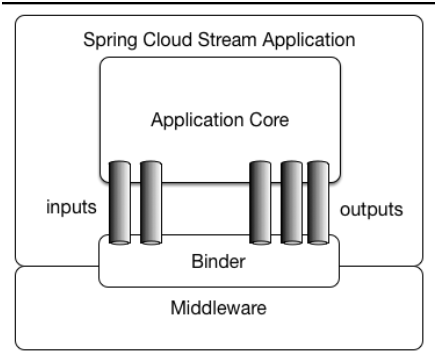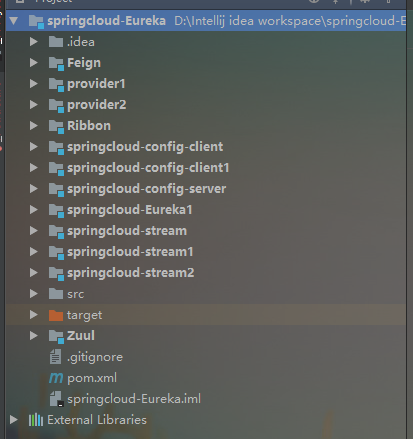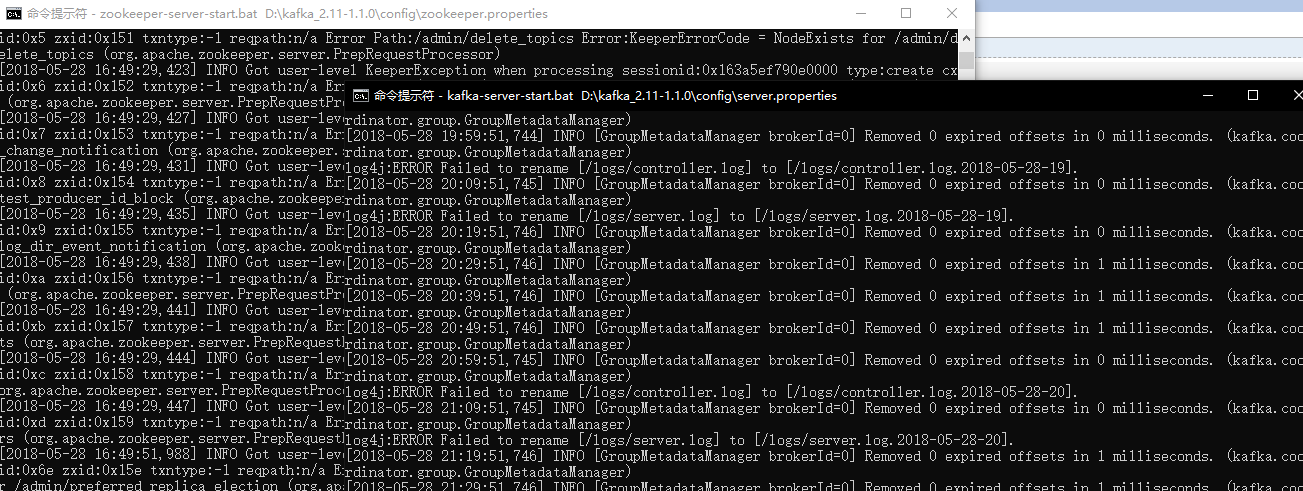SpringCloud Stream使用案例
官方定义 Spring Cloud Stream 是一个构建消息驱动微服务的框架。
这里还要讲解一下什么是Spring Integration ? Integration 集成
企业应用集成(EAI)是集成应用之间数据和服务的一种应用技术。四种集成风格:
1.文件传输:两个系统生成文件,文件的有效负载就是由另一个系统处理的消息。该类风格的例子之一是针对文件轮询目录或FTP目录,并处理该文件。
2.共享数据库:两个系统查询同一个数据库以获取要传递的数据。一个例子是你部署了两个EAR应用,它们的实体类(JPA、Hibernate等)共用同一个表。
3.远程过程调用:两个系统都暴露另一个能调用的服务。该类例子有EJB服务,或SOAP和REST服务。
4.消息:两个系统连接到一个公用的消息系统,互相交换数据,并利用消息调用行为。该风格的例子就是众所周知的中心辐射式的(hub-and-spoke)JMS架构。
为什么需要SpringCloud Stream消息驱动呢?
比方说我们用到了RabbitMQ和Kafka,由于这两个消息中间件的架构上的不同,像RabbitMQ有exchange,kafka有Topic,partitions分区,这些中间件的差异性导致我们实际项目开发给我们造成了一定的困扰,我们如果用了两个消息队列的其中一种,
后面的业务需求,我想往另外一种消息队列进行迁移,这时候无疑就是一个灾难性的,一大堆东西都要重新推倒重新做,因为它跟我们的系统耦合了,这时候springcloud Stream给我们提供了一种解耦合的方式。

Spring Cloud Stream由一个中间件中立的核组成。应用通过Spring Cloud Stream插入的input(相当于消费者consumer,它是从队列中接收消息的)和output(相当于生产者producer,它是从队列中发送消息的。)通道与外界交流。
通道通过指定中间件的Binder实现与外部代理连接。业务开发者不再关注具体消息中间件,只需关注Binder对应用程序提供的抽象概念来使用消息中间件实现业务即可。
Binder
通过定义绑定器作为中间层,实现了应用程序与消息中间件(Middleware)细节之间的隔离。通过向应用程序暴露统一的Channel通过,使得应用程序不需要再考虑各种不同的消息中间件的实现。当需要升级消息中间件,或者是更换其他消息中间件产品时,我们需要做的就是更换对应的Binder绑定器而不需要修改任何应用逻辑 。甚至可以任意的改变中间件的类型而不需要修改一行代码。目前只提供了RabbitMQ和Kafka的Binder实现。
Springcloud Stream还有个好处就是像Kafka一样引入了一点分区的概念,像RabbitMQ不支持分区的队列,你用了SpringCloud Stream技术,它就会帮RabbitMQ引入了分区的特性,SpringCloud Stream就是天然支持分区的,我们用起来还是很方便的。后面会详细讲解
接下来进行一个Demo进行演练。
首先我们要在先前的工程中新建三个子模块,分别是springcloud-stream,springcloud-stream1,springcloud-stream2 这三个模块,其中springcloud-stream作为生产者进行发消息模块,springcloud-stream1,springcloud-stream2作为消息接收模块。
如下图所示:

分别在springcloud-stream,springcloud-stream1,springcloud-stream2 这三个模块引入如下依赖:

- <dependency>
- <groupId>org.springframework.cloud</groupId>
- <artifactId>spring-cloud-stream-binder-kafka</artifactId>
- <version>1.3.0.RELEASE</version>
- </dependency>
- <dependency>
<groupId>org.springframework.boot</groupId>
<artifactId>spring-boot-starter-web</artifactId>
</dependency>

接着进行application.yml进行配置如下:

- server:
- port: 7888
- spring:
- application:
- name: producer
- cloud:
- stream:
- kafka:
- binder:
- #Kafka的消息中间件服务器
- brokers: localhost:9092
- #Zookeeper的节点,如果集群,后面加,号分隔
- zk-nodes: localhost:2181
- #如果设置为false,就不会自动创建Topic 有可能你Topic还没创建就直接调用了。
- auto-create-topics: true
- bindings:
- #这里用stream给我们提供的默认output,后面会讲到自定义output
- output:
- #消息发往的目的地
- destination: stream-demo
- #消息发送的格式,接收端不用指定格式,但是发送端要
- content-type: text/plain

接下来进行第一个springcloud-stream模块的代码编写,在该模块下定义一个SendService,如下:

- package hjc.producer;
- import org.springframework.beans.factory.annotation.Autowired;
- import org.springframework.cloud.stream.annotation.EnableBinding;
- import org.springframework.cloud.stream.messaging.Source;
- import org.springframework.messaging.support.MessageBuilder;
- /**
- * Created by cong on 2018/5/28.
- */
- //这个注解给我们绑定消息通道的,Source是Stream给我们提供的,可以点进去看源码,可以看到output和input,这和配置文件中的output,input对应的。
- @EnableBinding(Source.class)
- public class SendService {
- @Autowired
- private Source source;
- public void sendMsg(String msg){
- source.output().send(MessageBuilder.withPayload(msg).build());
- }
- }

springcloud-stream 的controller层代码如下:

- package hjc.producer;
- import org.springframework.beans.factory.annotation.Autowired;
- import org.springframework.web.bind.annotation.PathVariable;
- import org.springframework.web.bind.annotation.RequestMapping;
- import org.springframework.web.bind.annotation.RestController;
- /**
- * Created by cong 2018/5/28
- */
- @RestController
- public class ProducerController {
- @Autowired
- private SendService sendService;
- @RequestMapping("/send/{msg}")
- public void send(@PathVariable("msg") String msg){
- sendService.sendMsg(msg);
- }
- }

接下来进行springcloud-stream1,springcloud-stream2两个模块的代码编写
首先需要引入的依赖,上面已经提到。
接着进行springcloud-stream1和springcloud-stream2模块application.yml的配置,如下:
springcloud-stream1配置如下:

- server:
- port: 7889
- spring:
- application:
- name: consumer_1
- cloud:
- stream:
- kafka:
- binder:
- brokers: localhost:9092
- zk-nodes: localhost:2181
- auto-create-topics: true
- bindings:
- #input是接收,注意这里不能再像前面一样写output了
- input:
- destination: stream-demo

springcloud-stream2模块application.yml的配置如下:

- server:
- port: 7890
- spring:
- application:
- name: consumer_2
- cloud:
- stream:
- kafka:
- binder:
- brokers: localhost:9092
- zk-nodes: localhost:2181
- auto-create-topics: true
- bindings:
- input:
- destination: stream-demo

好了接下来进行springcloud-stream1模块和springcloud-stream2模块的消息接受代码的编写,springcloud-stream1模块和springcloud-stream2模块的消息接受代码都是一样的,如下:

- //消息接受端,stream给我们提供了Sink,Sink源码里面是绑定input的,要跟我们配置文件的imput关联的。
- @EnableBinding(Sink.class)
- public class RecieveService {
- @StreamListener(Sink.INPUT)
- public void recieve(Object payload){
- System.out.println(payload);
- }
- }

好了接着我们首先要启动上一篇随笔所提到的zookeeper,和Kafka,如下:

接着分别现后启动启动springcloud-stream,springcloud-stream1,springcloud-stream2,模块运行结果如下:
首先进行springcloud-stream模块的访问,如下:

回车后可以看到,Kafka CommitId,说明消息发送成功,再看一下,那两个消息接受模块的输出,如下:


可以看到这两消息模块都接收到了消息并且打印了出来。
好了到现在为止,我们进行了一个简单的消息发送和接收,用的是Stream给我们提供的默认Source,Sink,接下来我们要自己进行自定义,这种方式在工作中还是用的比较多的,因为我们要往不同的消息通道发消息,
必然不能全都叫input,output的,那样的话就乱套了,因此首先自定义一个接口,如下:

- /**
- * Created by cong on 2018/5/28.
- */
- public interface MySource {
- @Output("myOutput")
- MessageChannel myOutput();
- }

这里要注意一下,可以看到上面的代码,其中myOutput是要和你的配置文件的消息发送端配置对应的,因此修改springcloud-stream中application.yml配置,如下:

- server:
- port: 7888
- spring:
- application:
- name: producer
- cloud:
- stream:
- kafka:
- binder:
- #Kafka的消息中间件服务器
- brokers: localhost:9092
- #Zookeeper的节点,如果集群,后面加,号分隔
- zk-nodes: localhost:2181
- #如果设置为false,就不会自动创建Topic 有可能你Topic还没创建就直接调用了。
- auto-create-topics: true
- bindings:
- #自定义output
- myOutput:
- #消息发往的目的地
- destination: stream-demo
- #消息发送的格式,接收端不用指定格式,但是发送端要
- content-type: text/plain

这样还不行,还必须改造springcloud-stream消息发送端的SendService这个类,代码如下:

- package hjc.producer;
- import org.springframework.beans.factory.annotation.Autowired;
- import org.springframework.cloud.stream.annotation.EnableBinding;
- import org.springframework.cloud.stream.messaging.Source;
- import org.springframework.messaging.support.MessageBuilder;
- /**
- * Created by cong on 2018/5/28.
- */
- @EnableBinding(MySource.class)
- public class SendService {
- @Autowired
- private MySource source;
- public void sendMsg(String msg){
- source.myOutput().send(MessageBuilder.withPayload(msg).build());
- }
- }

接下来重新启动那三个模块,运行结果如下:


可以看到两个消息接收端还是依然能接受消息。
接收端的自定义接收也是类似的修改的,这里就不演示了。
springcloud-stream还给我们提供了一个Processor接口,用于进行消息处理后再进行发送出去,相当于一个消息中转站。下面我们进行演示
首先我们需要改造springcloud-stream1模块,把它作为一个消息中转站。用于springcloud-stream1消息处理后再进行发送给springcloud-stream2模块
首先修改springcloud-stream1模块的配置,如下:

- server:
- port: 7889
- spring:
- application:
- name: consumer_1
- cloud:
- stream:
- kafka:
- binder:
- brokers: localhost:9092
- zk-nodes: localhost:2181
- auto-create-topics: true
- bindings:
- #input是接收,注意这里不能再像前面一样写output了
- input:
- destination: stream-demo
- #进行消息中转处理后,在进行转发出去
- output:
- destination: stream-demo-trans

接着在新建一个消息中转类,代码如下:

- package hjc.consumer;
- import org.springframework.cloud.stream.annotation.EnableBinding;
- import org.springframework.cloud.stream.messaging.Processor;
- import org.springframework.integration.annotation.ServiceActivator;
- /**
- * Created by cong on 2018/5/28.
- */
- @EnableBinding(Processor.class)
- public class TransFormService {
- @ServiceActivator(inputChannel = Processor.INPUT,outputChannel = Processor.OUTPUT)
- public Object transform(Object payload){
- System.out.println("消息中转站:"+payload);
- return payload;
- }
- }

接着要修改消息中转站发送消息出去的接收端springcloud-stream2的配置,如下:

- server:
- port: 7890
- spring:
- application:
- name: consumer_2
- cloud:
- stream:
- kafka:
- binder:
- brokers: localhost:9092
- zk-nodes: localhost:2181
- auto-create-topics: true
- bindings:
- input:
- destination: stream-demo-trans

这里要强调一下,要把先前RecieveService类的绑定注解全都注释掉,不然,会绑定冲突的,接下来分别重启这三个模块,运行结果如下:
先进性springcloud-stream模块的访问。

中转站运行结果取下:

接下来,看中转后的的接受端Springcloud-stream2的消息,到底有没有消息过来,如下:

可以看到,中转后消息被接受到了。
我们还可能会遇到一个场景就是,我们接收到消息后,给别人一个反馈ACK,SpringCloud stream 给我们提供了一个SendTo注解可以帮我们干这些事情。
首先我们先实现一个接口SendToBinder去实现output和input,代码如下:

- package hjc.consumer;
- import org.springframework.cloud.stream.annotation.Input;
- import org.springframework.cloud.stream.annotation.Output;
- import org.springframework.messaging.MessageChannel;
- import org.springframework.messaging.SubscribableChannel;
- /**
- * Created by cong on 2018/5/28.
- */
- public interface SendToBinder {
- @Output("output")
- MessageChannel output();
- @Input("input")
- SubscribableChannel input();
- }

接着再新建一个SendToService类来绑定自己的SendToBinder接口,然后监听input,返回ACK表示中转站收到消息了,再转发消息出去,代码如下:

- package hjc.consumer;
- import org.springframework.cloud.stream.annotation.EnableBinding;
- import org.springframework.cloud.stream.annotation.StreamListener;
- import org.springframework.messaging.handler.annotation.SendTo;
- /**
- * Created by cong on 2018/5/28.
- */
- @EnableBinding(SendToBinder.class)
- public class SendToService {
- @StreamListener("input")
- @SendTo("output")
- public Object receiveFromInput(Object payload){
- System.out.println("中转消息。。"+payload);
- return "xxxxx";
- }
- }

这里要注意一点就是,启动前下那边之前的用到的哪些绑定注解,先注释掉,不然与这里会发生冲突。
运行结果如下:


可以看到发送端受到一个ACK
可以看到先前的例子,我们都是一端发消息,两个消息接受者都接收到了,但是有时候有些业务场景我只想让其中一个消息接收者接收到消息,那么该怎么办呢?
这时候就涉及一个消息分组(Consumer Groups)的概念了。
消息分组(Consumer Groups)
“Group”,如果使用过 Kafka 的读者并不会陌生。Spring Cloud Stream 的这个分组概念的意思基本和 Kafka 一致。微服务中动态的缩放同一个应用的数量以此来达到更高的处理能力是非常必须的。对于这种情况,同一个事件防止被重复消费,
只要把这些应用放置于同一个 “group” 中,就能够保证消息只会被其中一个应用消费一次。不同的组是可以消费的,同一个组内会发生竞争关系,只有其中一个可以消费。

- server:
- port: 7889
- spring:
- application:
- name: consumer_1
- cloud:
- stream:
- kafka:
- binder:
- brokers: localhost:9092
- zk-nodes: localhost:2181
- auto-create-topics: true
- bindings:
- #input是接收,注意这里不能再像前面一样写output了
- input:
- destination: stream-demo
- #分组的组名
- group: group

接着修改springcloud-stream2模块的配置,代码如下:

- server:
- port: 7890
- spring:
- application:
- name: consumer_2
- cloud:
- stream:
- kafka:
- binder:
- brokers: localhost:9092
- zk-nodes: localhost:2181
- auto-create-topics: true
- bindings:
- input:
- destination: stream-demo-trans
- group: group

可以看到springcloud-stream1和springcloud-stream2是属于同一组的。springcloud-stream模块的发的消息只能被springcloud-stream1或springcloud-stream2其中一个接收到,这样避免了重复消费。
springcloud-stream1模块代码恢复成如下代码:

- package hjc.consumer;
- import org.springframework.cloud.stream.annotation.EnableBinding;
- import org.springframework.cloud.stream.annotation.StreamListener;
- import org.springframework.cloud.stream.messaging.Sink;
- /**
- * Created by cong on 2018/5/28.
- */
- //消息接受端,stream给我们提供了Sink,Sink源码里面是绑定input的,要跟我们配置文件的imput关联的。
- @EnableBinding(Sink.class)
- public class RecieveService {
- @StreamListener(Sink.INPUT)
- public void recieve(Object payload){
- System.out.println(payload);
- }
- }

springcloud-stream2的接收端代码不变,依然跟上面代码一样。
接着,运行结果如下:

控制台如下:


可以看到只有其中一个受到消息。避免了消息重复消费。
有时候我们只想给特定的消费者消费消息,那么又该真么做呢?
这是后又涉及到消息分区的概念了。
消息分区()
Spring Cloud Stream对给定应用的多个实例之间分隔数据予以支持。在分隔方案中,物理交流媒介(如:代理主题)被视为分隔成了多个片(partitions)。一个或者多个生产者应用实例给多个消费者应用实例发送消息并确保相同特征的数据被同一消费者实例处理。
Spring Cloud Stream对分割的进程实例实现进行了抽象。使得Spring Cloud Stream 为不具备分区功能的消息中间件(RabbitMQ)也增加了分区功能扩展。
那么我们就要进行一些配置了,比如我只想要springcloud-stream2模块接收到消息,
springcloud-stream2配置如下:

- server:
- port: 7890
- spring:
- application:
- name: consumer_2
- cloud:
- stream:
- kafka:
- binder:
- brokers: localhost:9092
- zk-nodes: localhost:2181
- auto-create-topics: true
- bindings:
- input:
- destination: stream-demo-trans
- group: group
- consumer:
- #开启分区
- partitioned: true
- #分区数量
- instance-count: 2

生产者端springcloud-stream模块配置如下:

- server:
- port: 7888
- spring:
- application:
- name: producer
- cloud:
- stream:
- kafka:
- binder:
- #Kafka的消息中间件服务器
- brokers: localhost:9092
- #Zookeeper的节点,如果集群,后面加,号分隔
- zk-nodes: localhost:2181
- #如果设置为false,就不会自动创建Topic 有可能你Topic还没创建就直接调用了。
- auto-create-topics: true
- bindings:
- #自定义output
- myOutput:
- #消息发往的目的地
- destination: stream-demo
- #消息发送的格式,接收端不用指定格式,但是发送端要
- content-type: text/plain
- producer:
- #分区的主键,根据什么来分区,下面的payload.id只是一个对象的id用于做为Key,用来说明的。希望不要误解
- partitionKeyExpression: payload.id
- #Key和分区数量进行取模去分配消息,这里分区数量配置为2
- partitionCount: 2

其他的代码基本不变,这里就不演示了。这里要给大家说明一下,比如分区的Key是一个对象的id,比如说id=1,每次发送消息的对象的id为相同值1,则消息只会被同一个消费者消费,比如说Key和分区数量取模计算的结果是分到stream2模块中,那么下一次进行进行消息发送,
只要分组的key即id的值依然还是1的话,消息永远只会分配到stream2模块中。
SpringCloud Stream使用案例的更多相关文章
- 九. SpringCloud Stream消息驱动
1. 消息驱动概述 1.1 是什么 在实际应用中有很多消息中间件,比如现在企业里常用的有ActiveMQ.RabbitMQ.RocketMQ.Kafka等,学习所有这些消息中间件无疑需要大量时间经历成 ...
- 每天学点SpringCloud(十四):Zipkin使用SpringCloud Stream以及Elasticsearch
在前面的文章中,我们已经成功的使用Zipkin收集了项目的调用链日志.但是呢,由于我们收集链路信息时采用的是http请求方式收集的,而且链路信息没有进行保存,ZipkinServer一旦重启后就会所有 ...
- Rabbitmq基本使用 SpringBoot整合Rabbit SpringCloud Stream+Rabbit
https://blog.csdn.net/m0_37867405/article/details/80793601 四.docker中使用rabbitmq 1. 搭建和启动 使用地址:rabbitm ...
- 《springcloud 五》springcloud stream
什么是消息驱动? SpringCloud Stream消息驱动可以简化开发人员对消息中间件的使用复杂度,让系统开发人员更多尽力专注与核心业务逻辑的开发.SpringCloud Stream基于Spri ...
- SpringCloud学习笔记(九、SpringCloud Stream)
目录: 什么是SpringCloud Stream 如何使用SpringCloud Stream 消息分流 什么是SpringCloud Stream: SpringCloud Stream是一个用于 ...
- SpringCloud Stream 消息驱动
1.什么是消息驱动 SpringCloud Stream消息驱动可以简化开发人员对消息中间件的使用复杂度,让系统开发人员更多尽力专注与核心业务逻辑的开发.SpringCloud Stream基于Spr ...
- Java8 新特性学习 Lambda表达式 和 Stream 用法案例
Java8 新特性学习 Lambda表达式 和 Stream 用法案例 学习参考文章: https://www.cnblogs.com/coprince/p/8692972.html 1.使用lamb ...
- SpringCloud系列之SpringCloud Stream
SpringCloud Stream SpringCloud Config SpringCloud Gatewa SpringCloud Hystrix SpringCloud 第一部分 文章目录 S ...
- 使用SpringCloud Stream结合rabbitMQ实现消息消费失败重发机制
前言:实际项目中经常遇到消息消费失败了,要进行消息的重发.比如支付消息消费失败后,要分不同时间段进行N次的消息重发提醒. 本文模拟场景 当金额少于100时,消息消费成功 当金额大于100,小于200时 ...
随机推荐
- 尝试在Mac/iOS上使用tcmalloc库
概述 TCMalloc 是 Google 开发的内存分配器,在不少项目中都有使用,例如在 Golang 中就使用了类似的算法进行内存分配.它具有现代化内存分配器的基本特征:对抗内存碎片. ...
- cache verilog实现
cache原理: https://www.cnblogs.com/mikewolf2002/p/10984976.html cache的verilog实现 实现的cache是16k, 4way组相连c ...
- Bugku 多次
网址:http://123.206.87.240:9004/1ndex.php?id=1 前言:bugku中一涉及多次注入的题 1.异或注入(判断字符是否被过滤) 0X00 很明显 注入点在id上 ...
- The Preliminary Contest for ICPC Asia Shenyang 2019 H. Texas hold'em Poker
题目链接:https://nanti.jisuanke.com/t/41408 题目意思很简单,就是个模拟过程. #include <iostream> #include <cstr ...
- Jupyter Notebook 更换主题(背景、字体)
通过命令行窗口或 Anaconda Prompt 窗口 1.安装 Jupyter 主题 pip install jupyterthemes 2.更新 Jupyter 主题 (可选) pip insta ...
- Linux中的会话与作业
- 修改/etc/docker/daemon.json中的log-opts配置发现无效 docker 限制日志大小
https://colobu.com/2018/10/22/no-space-left-on-device-for-docker/ 在/etc/docker/daemon.json中修改或添加log- ...
- ABP 后台调用接口 获取返回的数据
原文:https://www.cnblogs.com/i3yuan/p/10703500.html insert 简单测试: public void test8() { string url = &q ...
- ESA2GJK1DH1K基础篇: 测试APP使用SmartConfig绑定Wi-Fi 设备并控制设备
前言 实现功能概要 STM32控制WI-Fi模块以AT指令TCP透传方式连接MQTT服务器, 实现MQTT通信控制. 测试准备工作(详细下载步骤请参考 硬件使用说明 ) 一,下载单片机程序 二,安装A ...
- 【数论】[圆点坐标]P2508圆上的整点
题目描述 求一个给定的圆\(x ^2 +y ^2 = r ^2\),在圆周上有多少个点的坐标是整数 Solution 圆上的点坐标通解:\(x = d\frac{v^2-u^2}{2},y = duv ...
